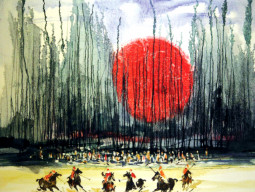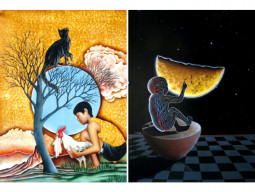
ISLAMABAD:
Carefully gripping chopsticks, delicate spoons and feathers as tools to place various sized natural stones and measured amounts of white sand on black lacquer to create a multidimensional mystical scene of seaside. Midori Inomata demonstrated the art of Boneski.
At the Islamabad Foreign Women’s Association (IFWA) here on Wednesday, Midori Inomata, the wife of the Japanese Ambassador, sat at a table supported by bright spotlights. As the group of women were initially seated listening to the procedure, as Inomata proceeded towards the final stages, they could not resist but to crowd around the table documenting it with their cell phones.
With everyone’s eyes engrossed at the table, observing her delicate hand movements, Inomata explained that Boneski was is a traditional Japanese art that is done with immense concentration.
With the use of a black base, the textures used on top were in white creating a space for contrast and dimension. The miniature work is done by placing natural stones on black lacquer trays with various size and amounts of white sand used to add dimension.
The multidimensional view of a scene is inspired by the four scenes. It often depicts mountains, seashores, and gardens. Small stones are used to represent mountains, shore lines or rocky islands that waves break upon. Miniature structures, usually of painted copper, are sometimes added to the work to make houses, temples, bridges, and the like.
Stone, being hard, strong, and not easily changed, evokes strong marital ties, harmonious relations, and longevity explained Inomata. “In the old days, while receiving guests, one may have burnt incense to purify the place and prepare stone decoration to symbolise long-lasting peace and good health” she added.
The stones and sand can be returned to their original state by sieve or rearranged to create a different scene. This form of one-time or impermanent enjoyment, as well as its decisiveness can be said to relate to Japanese cultural ideas such as Bushd-way of Japanese warrior knight.
It is said that Bonseki began in the seventh century, when Empress Suiko admired a mountain-shaped stone that was attached to the lid of an incense burner, a “Hakusan-Koro”, which had been placed on a tray for her crown.
“I think it is extremely therapeutic just watching her make this with so much patience” said a participant from Holland. “It is a totally new experience for most of us. We might have seen this form of art, but never really thought of the amount of patience and hard work that goes into creating it,” said Farah Rani.
Published in The Express Tribune, May 1st, 2014.





















































COMMENTS
Comments are moderated and generally will be posted if they are on-topic and not abusive.
For more information, please see our Comments FAQ